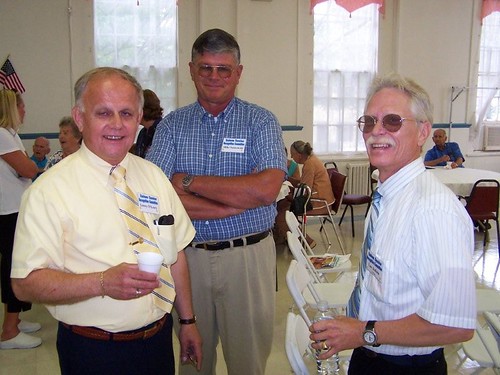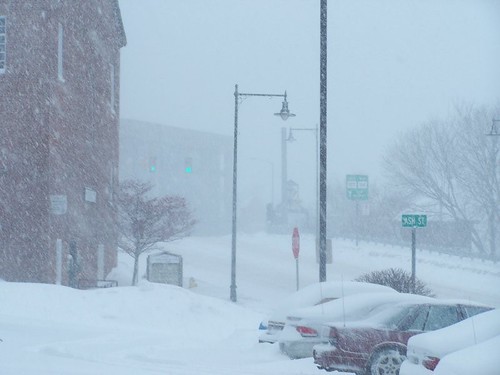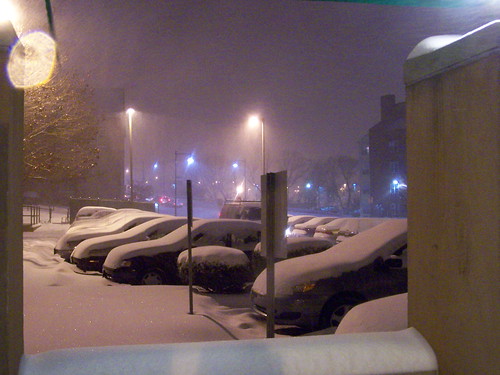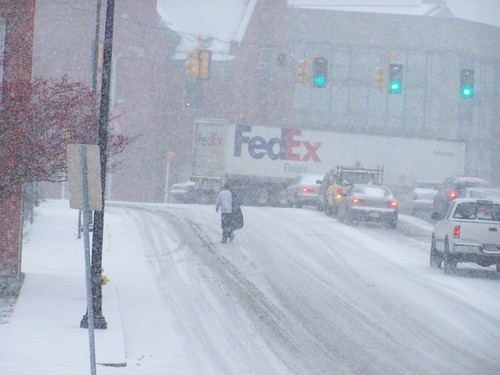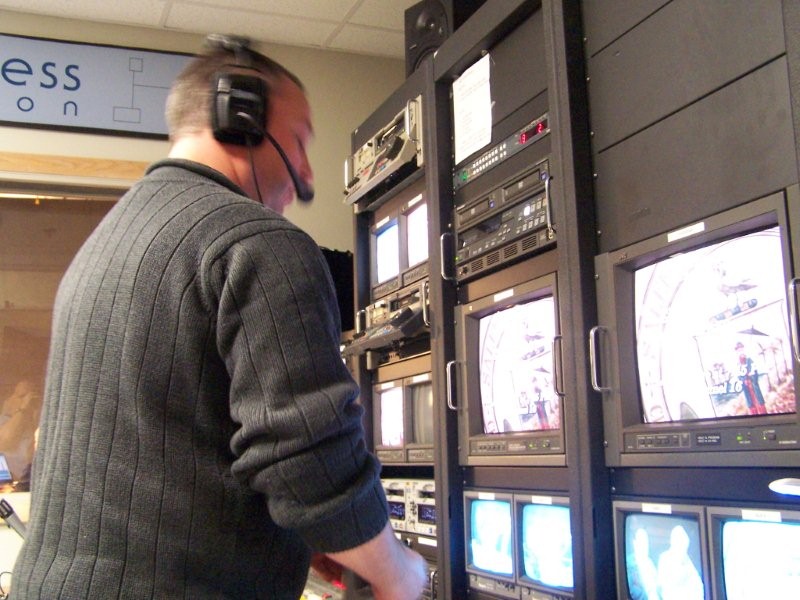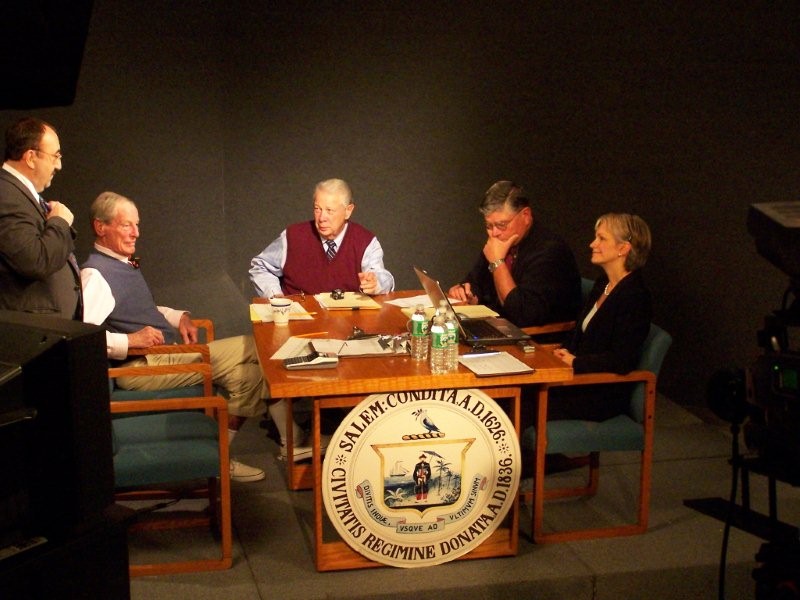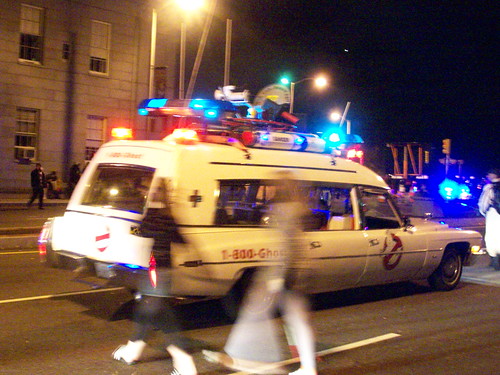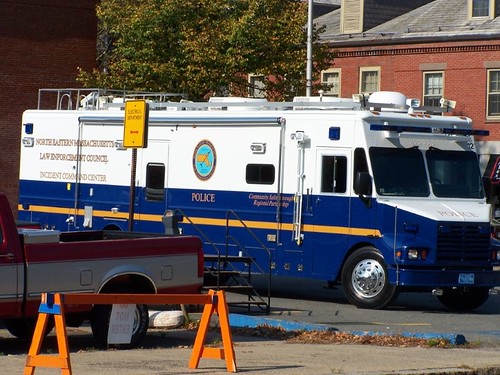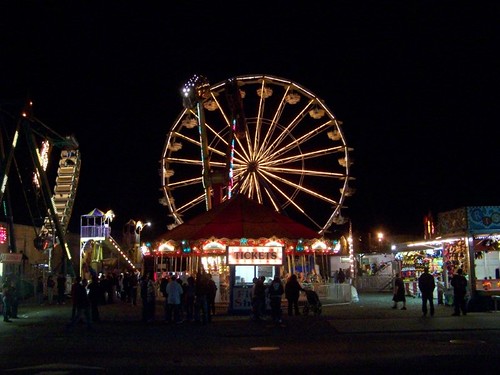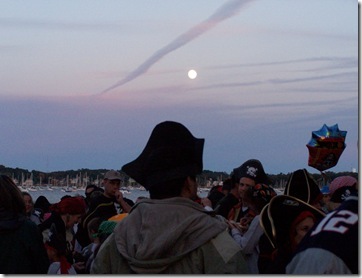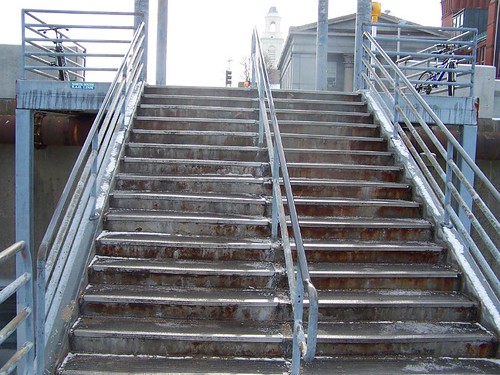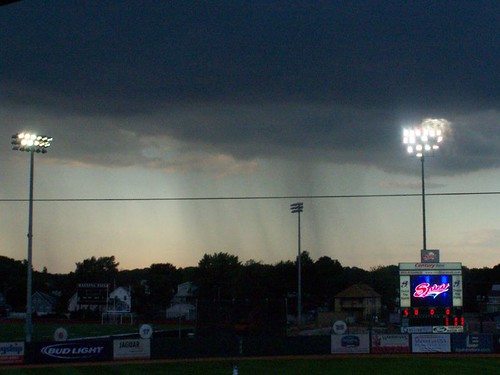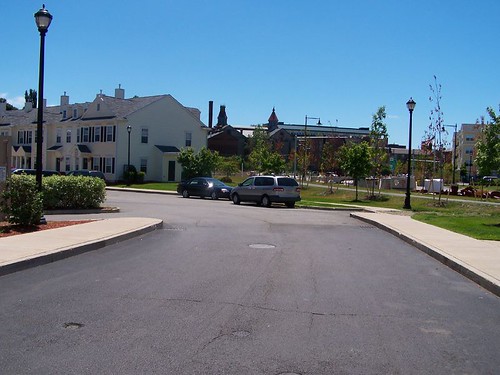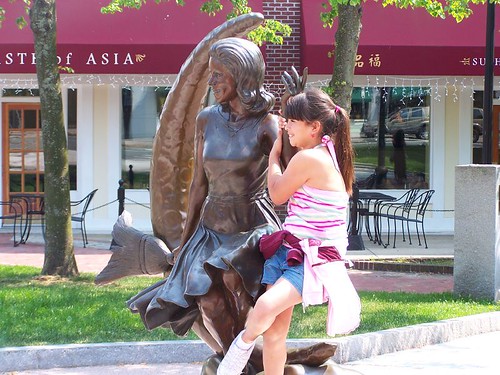My friend Leo Jodoin emailed me Friday night: Long-time councilor Leonard F. O'Leary passed away. I was never a consituent of Lenny's, as my family moved out of Gallows Hill when Frances Grace was still councilor, but he and I and our mutual friend Leo Jodoin, worked together on Leo's Salem Senior Recognition Days.
The photo above shows Lenny, my ward councilor and Commission liason Mike Sosnowski and Leo, together at last year's Recognition Days ceremony. We had wanted Lenny to be the master of ceremonies in 2007 as he had been for the past two years of the event, but he had been sick that day.
Lenny was a frequent guest on Salem Now and a very familiar presence at SATV.
I'm normally deeply cynical about local politics, but we and Salem will really miss Lenny. Many of the really influential old-timers in Salem that remember life before condos, history as property values, and "hip, cool, dynamic residents", the truly living history, are beginning to pass from us.
We will come to regret their passing bitterly, as in many ways Lenny and others of his generation were the best of Salem, in ways I don't expect my generation or even the one before it, to ever match.
Update: The 2008 Salem Senior Recognition Days is dedicated to Lenny.
Sunday, December 23, 2007
Lenny O'Leary is no longer with us
Saturday, December 22, 2007
More icy sidewalks, hazardous for those in wheelchairs
Continuing the last topic of dangerous walking, we at the Salem Commission on Disabilities could just specialize in sidewalks--we'd still have more work than we could handle!
This quote from today's Globe:
If you think it has been tough trudging along Boston's snowy, icy, slushy streets and sidewalks this week, try it in a wheelchair.
The city has been a frozen obstacle course for people with disabilities, a problem compounded by businesses, institutions, and state and city agencies that have ignored their obligation to clear the way for people in wheelchairs to get from their homes to city streets, according to an advocacy group for the disabled.
Among those failing to sufficiently clear away snow have been the state's Division of Conservation and Recreation, Northeastern University, and the Boston Symphony Orchestra, said the organization, called the Neighborhood Access Group.
"It's pervasive, unrelenting, and demoralizing," said the head of the group, John Kelly. He said some members may not attend their own holiday party this afternoon at a housing complex in the Fenway, because sidewalks in the vicinity are still impassable, crosswalks blocked, and wheelchair ramps treacherous.
"Many of us can't even leave our houses," he said. (emphasis added)
Several years ago, the Commission went through this problem with the Post Office in Salem. This building had a ramp retrofitted to it, running in a serpentine route to the right of the main entrance.
It was closed during the winter due to ice dams building up on the roof. Repairs to the roof were tied up for a long time due to bureaucracy. Wheelchair users were supposed to go in through the rear of the building, which is employees-only and a private area. In the meantime, 9/11 happened, and the post office was somehow convinced that it might not be a great idea for the chair-using public to pass through sensitive areas. The roof got its repairs this year and the ramp is now open, at least so far this winter.
This season, one of my fellow commissioners is fighting with the YMCA over snow removal. The YMCA building on the corner of Sewall & Essex is also the site of the Zisson elderly/disabled housing complex. The van space in front of the building has been continually blocked by an endless array of snowbanks, construction vehicles, illegally-parked cars and other such obstacles.
The parking lot, as most parking lots around the city, is choked with snow. Elderly vans and chair cars can't take on or let off their passengers. Snowmelt makes things worse as huge puddles (1" to as much as 3" deep!) form at the base of ramps where they meet the street surface. It's bad enough just walking through an inch of water, never mind in a chair or on crutches! Also, many crosswalks are located at or near storm drains and these are often clogged with snow allowing enormous curb-swallowing rivers to form!
Boston's Neighborhood Access Group is on the case! They have an excellent blog with a lot of incriminating pictures that clearly show icy sidewalks impassible to the disabled.
Most able-bodied people navigate these crossings with a lot of frustration but take them for granted; it's winter, after all. I used to do the same thing. Lately, I've started looking at the three-foot snowbanks I find outside the grocery store and saying, "Why do I have to climb over this for another year in a row! Waiting in the street for the bus doesn't build character!"
I wish I had the answer.
Globe article: Icy walkways create a special challenge for those in wheelchairs - The Boston Globe
Wednesday, December 19, 2007
Dangerous Walking
Every year that there's significant snow in the winter (not last year), there are plows. And covered sidewalks. And steep snowbanks. This winter is starting out like usual, and very tragically for one person.
In Blackstone, a woman walking home with her groceries, unable to walk on the sidewalk due to snowbanks, was run down by a snowplow and killed.
Several years ago, we in the disability community in Salem lost one of our best people, Tiffany Park, when she and her scooter were run down in Lynn, when she was on the way to church services. She was also forced to use the street.
For the most part, I accept winter and the compromises one has to make. I accept that I might have more problems getting around.
But I am perennially dismayed and frustrated at the great number of unplowed sidewalks in and around Salem. City ordinance requires sidewalks to be shoveled after a storm. But that's not the biggest problem.
The way in which streets are plowed after storms is even worse. Imagine a street with a T intersection, crossed by another street or, most commonly, a driveway. Usually, one plow driver from the DPW will take care of the street. A private operator with another truck or a Bobcat will do the driveway that might go back into a parking lot. The two plows will work and move the snow.
The snow ends up on the sidewalk. The natural action of the plows pushes snow to the sides, and when a plow crosses a street to do a driveway, the snow builds up in huge pillars at the corners.
Even if sidewalks are plowed in front of any one building, one often cannot go on the sidewalk; it may be blocked by a pillar, or black ice at a driveway, etc.
For walking any distance, I am forced in the street. This is downright scary.
My neighborhood, the street grid around St. Peter & Federal is one example that proves my point, with its many driveways into 10 Federal, St. John's and St. Peter's Church. Even when an individual building is plowed, the driveways make it very treacherous to walk. The Museum Place lot has no plowed sidewalks at all.
As well, many commercial establishments will plow their parking lots but not the public sidewalks that front them. The most dangerous place in Salem, I'm convinced, is the bus stop outside Market Basket (northbound Highland Ave.) Jersey barriers are more forgiving than the frozen snowbanks that cover the sidewalk there. It is not possible for even an able-bodied person (and I am NOT mobility-impaired!) to mount the snowbanks to wait for a bus.
Snow plowing and its responsiblities (and fines!) have been very contentious in Salem in past winters. This has been discussed at our commission meetings; unfortunately, too many feel that people complaining about sidewalks should move to Florida or stay homebound in the winter. I'm certainly not thrilled about bringing this issue up every year.
Source: WHDH-TV - New England News - Police seek snow plow driver after hit-and-run death
Sunday, December 16, 2007
Another winter storm
Thursday, December 13, 2007
First storm of Winter '07-'08, continued
UPDATE: The final snow total at my house (St. Peter @ Bridge) is 9".
Salem's first big storm for Winter '07-'08
Salem's first big storm for December is well underway...
Sunday, December 2, 2007
The 2 x 10 Program: Leveling the playing field for the blind in Massachusetts
I was alerted to an item from the Perkins School for the Blind:
Did you know that over 35,000 people in Massachusetts are registered as legally blind? This does not account for those who are unregistered or who have severe vision loss but do not qualify as legally blind. The unmet needs among this group are many. They are significant and directly impact many aspects of life for each individual. For example, the survey showed that:
- 77% of blind residents under the age of 65 are unemployed
- 41% of blind residents identify transportation as their greatest program
- Only 18% of blind residents use a computer
- 38% of blind adults have limited social and recreational lives because of their vision.
To help those legally blind and low vision citizens, Perkins has announced the 2 x 10 Program that calls for Massachusetts to allocate $2 million by 2010 in the House budget towards programs for the blind and visually impaired.
There is an online petition that's addressed to Deval Patrick, JudyAnn Bigby (Massachusetts Health and Human Services) and Leslie Kirwan (Secretary of Administration and Finance). You can fill it out, but I think written letters would have more impact.
Of course, the Salem Commission on Disabilities will almost certainly support this, but if you or a loved one are vision-impaired, I urge you to write them yourself with your story.
Hat tip to Blue Mass. Group:: leveling the playing Field for Mass. Blind
Tuesday, November 27, 2007
Election Postscript and Voting Machines
My friend Leo is happy today: Jerry Ryan came through his recount and is still the Ward 4 councilor-elect. Leo's a big Ryan supporter; I only hope it works out--I'm a lot more cynical and a lot less enthusiastic about individual politicians than he is. One only has to look at the state house and the parade of low expectations in the corner office to know what I speak of ("Together we can...Casinos! Casinos!")
During this past election, I was very interested in how the Automark voting machines would work and wanted to try one. I could have really used it last year when I was nearly blind from complications from my cataract implant and could barely read the ballot during the gubernatorial election.
This is the Automark:
When a disabled person votes, he or she gets the ballot in the usual way after checking in with the poll workers. The ballot is identical to the ones other voters mark with pens.
The voter feeds the ballot into the machine, and follows the instructions on the screen. There are headphones with audio instructions for the blind.
The voter navigates through the ballot and makes choices through either the touch screen or the navigation keys on the right.
It is straightforward to anyone who has ordered online or made selections on a web page. (There is support for write-ins but I didn't try this so I'm not sure how that works.)
After making selections, you can either commit your ballot or go back to change your selections. Commit your ballot, and the machine will print marks on the ballot and feed it back out to you, where you then put the ballot back in its sleeve and go to the poll workers to turn it in as usual.
It's a transparent process without any of the well-known problems that beset the Diebold machines. The machine worked very well for me.
But I'm concerned. The Commission, and myself, are very interested in how many people take advantage of the accommodations for people with disabilities that we work towards. We often hear the refrain, "but how can we spend money on only a few disabled people!?", and we fight the "tyranny of the majority" all the time.
The Commission wanted to know how many disabled voters used the Automark. Apparently, the machines don't store that information. This is probably because the machine is not a voting machine like the old lever machines but is just a ballot marking device.
For example, If you cast a vote by mistake, you are allowed up to two more ballots (the third ballot counts.) The Automark can't know how many unique voters come up to cast ballots--there is no voter login procedure--but at best, how many ballots were fed through it, and they may not even provide that information.
The other problem with the machines brought to our attention during the last Commission meeting, is that they are heavy, 80 lbs. each, and at one per precinct, there are 14 of these to lug around.
Cheryl LaPointe (our city clerk) and her staff are nothing less than professional, but they were understaffed up to Election Day. Several of us on the Commission offered to volunteer to move the machines for next time, but it's not clear we can legally do that.
I only know three people who used the Automark: myself (the first voter in my precinct to do so), Charlie Reardon and Andrew LaPointe. We don't and perhaps can't know of any other voters who took advantage of the machine.
The state requires these machines so they aren't going away. We'll be using them next for the presidential primary.
Still I worry about some clerk in a town somewhere saying to the state, "The only disabled people in my town are in institutions, why do we all need these machines!"
I'd hate to lose that machine. This past election was the first time I had ever been able to cast a ballot after first being able to read it! Usually, I just guessed at it, knowing that one blob meant "Harvey" and another meant "Deval", or "No on Question N". I'm usually very well prepared before I enter the polls, but low vision is miserably demoralizing.
The Automark works very well.
The right likes to talk about civil rights organizations being obsolete because "they won already!", but this is why I'm on the Commission. We may win our rights but we still have to fight to keep them.
Saturday, November 10, 2007
2007 Election Night Photos
Pictures from Election Night at SATV
Our director, Dave Gauthier.
The Election 2007 hosts, just before airtime. Mike Allen, standing, Bill Burns, George Ahmed, Mike Sosnowski and Claudia Chuber.
My crew position at the graphics console.
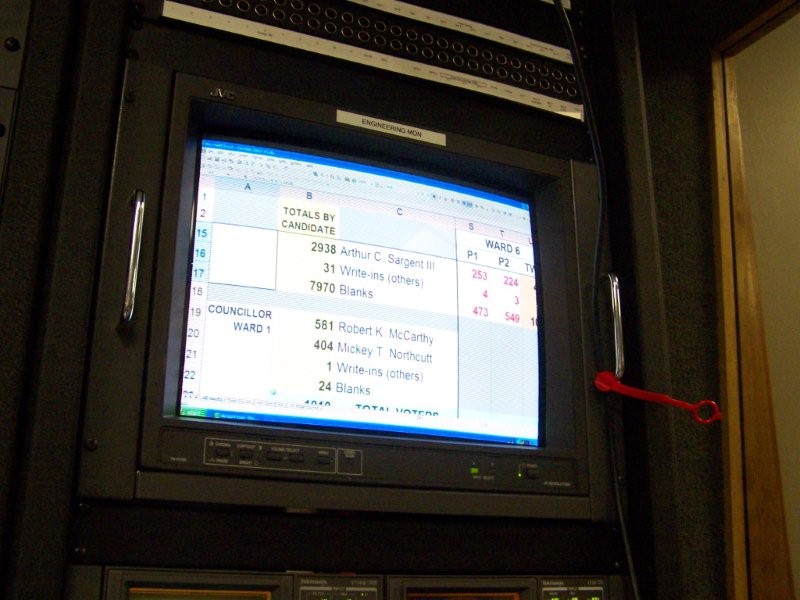
Claudia Chuber's excellent spreadsheet.
Friday, November 9, 2007
Inaccuracies in North Shore Sunday article about blogging
I was contacted earlier this week by Barbara Taormina about what I thought was my blog. I told her about my work with SATV and the Salem Commission on Disabilities, and that I would be liveblogging the elections from SATV, which I did do.
I read the article this morning, and I really need to make a correction. Ms. Taormina cites my blog at http://salempolitics.blogspot.com/ That's not my blog. It's a good blog but it isn't mine. Mine is http://salemmassblog.blogspot.com/ Of course, I'd wish I'd known about it before the article hit.
I've been trying to reach the proprietor of Salem Politics to give him or her a heads-up but there's no email listed.
I have to wonder just how she found me and whether or not she actually read my blog. I think my name came up somewhere and she found Salem Politics and conflated us both.
Tuesday, November 6, 2007
Salem Election 2007 final results
UPDATE: Ward 4 is a statistical dead heat: Ryan, 600, Barton, 579.
Question 1 has been defeated.
Ward Four had the most votes cast, followed by Ward One; both wards had important contested races.
The Salem News reported the turnout at 35%.
I'd like to thank Claudia Chuber for her excellent spreadsheet without which SATV could not have put up the results so quickly, and Claire White-Sullivan for standing by at City Hall to phone in the results. And thanks to SATV for letting me blog this while doing my "real" graphics work.Once again the results are unofficial! [still unofficial in Ward 4 as I write this Wednesday.]
Salem Gazette coverage
Salem News coverage
Welcome to the live blog of Salem's 2007 election
Welcome to my live blog of the 2007 municipal elections in Salem, Massachusetts, for Tuesday, November 6th!
As I'm writing this, the polls have yet to close. It's 7 PM. If you're in Salem and haven't yet voted as you read this, there's still time, go!
There are six races in contention this year: School Committee, Councilor at Large, Ward 1, Ward 3, Ward 4 and Ward 5. Ward 2, Ward 6 and Ward 7 have no opposition. There is no mayoral election this year; that election takes place every 4 years and the next one is in 2009 per charter.
As I post the results, keep in mind that they are unofficial! The results are usually certified by the clerk on Wednesday, unless there is a recount.
I'm posting from Salem Access Television, where we are broadcasting the results live on Channel 16 starting at 7:35. Hosting our coverage are: George Ahmed, Inside Salem, Mike Allen, former School Committee member, Bill Burns, former city councilor, Mike Sosnowski, Ward 2 Councilor (my ward), and Claudia Chuber, former School Committee member.
Mrs. Chuber will keep track of the results as they are phoned in from City Hall, and I'll post them from my position in the control room. I'll keep this blog updated as best I can but I have a "real" job as a graphics operator and this takes precedence, or so my director tells me!
Note also that I'll be writing in a neutral point of view (NPOV as they say on Wikipedia). I don't make endorsements for or against and I'll leave the editorial comments out; plenty of time for that tomorrow!
Details on the candidates in my next post.
Educational classism and our broken state colleges
Deval Patrick is looking for $2 billion to renovate state college campuses:
[Corrected figure--Thanks, Henry!]
At Fitchburg State College, decades-old lead pipes in the science center mean students can't drink the water. Bunker Hill Community College hasn't added a building since it opened in 1973, forcing it to hold overflow classes late at night and on weekends. Salem State College has closed its 38-year-old library indefinitely because of fears its foundation is failing.
"When students and parents see Jersey barriers around the library, that's hard to explain," said Patricia Maguire Meservey, president of Salem State College. Newcomers to the college's science facilities, she said, feel as though "they are stepping back in time."
I'm a graduate of Salem State (class of '87) and I can confirm both these points. I had a work-study job at the library for the five years I was there. Even then, there were serious problems with the building. One year, the elevators had to be taken out of service: The roof over the elevator shaft leaked and seriously rusted one of the elevator cabs, at the top where the cables are attached.
The physics lab I had classes in had barely changed since Meier Hall was built in the '60's. The second-semester physics lab, which covered electromagnetic theory, used 30-year old voltohmmeters. They were in good shape, but I had newer tools at home as an electronics enthusiast. I and my lab supervisor probably would have preferred newer Fluke meters that are safer and less prone to being blown up or broken by clumsy students.
You'd think we'd want a good state college system with enough money to let those students on the wrong end of the economic scale (as I was then) have the same opportunities as Harvard-educated students, but that's not so.
Earlier this year, State Rep Doug Petersen (D-Marblehead), was speaking at a Swampscott School Committee earlier this year about school aid.
Quote via Pazdziernik:
When answering a question dealing with state aid and the disparity of aid between Swampscott and Lynn, Petersen said, “At no point has anyone from Swampscott ever called me, nor will they ever call me to get their child into a Lynn school,” Petersen said. He continued to say, a lot of Swampscott kids are going to be captains of industry someday and you want those Lynn kids to be educated because they are your future employees.“The way I used the analogy was wrong and if I could take it back and do it again I certainly would,” Petersen said.
“I certainly wish I could have phrased it in a different way,” Petersen said. (State Rep. Petersen backpedals on insults to Lynn students by Henry J. Collins, The Daily Item)
Translation: He wishes that he hadn't spoken from his heart. There are things that no elected official can ever say out loud and this is one of them. But I have no doubt that, to a person, most if not all state elected officials have this same thought in mind.
(Rep. Petersen's Youtube appearance.)
In the early '90's, a few years after I graduated from Salem State, the Boston Globe wrote an editorial I was very upset with. The editorial--unfortunately locked up behind the paywall of Lexis--expressed gratitude that Massachusetts had both a concentration of prestigious private schools (Harvard, MIT, etc.) and a state college system, and that the graduates of these private schools had a state college system to turn out workers for them. In other words as best I remember: We have private schools to turn out entrepreneurs and public schools to turn out the little folk who work for these bigshots.
There wasn't a lot of outrage over that editorial, perhaps a letter or two. No doubt that Globe editorial spoke for a lot of people.
Another quote from LaborStandard.org:
That question leaps to the heart of the matter, and the answer is a not-so-simple: “No, of course not, but… yes.” No, the upper-class kids are not inherently better than their working class peers. The indignation of the Lynn parent is based on the democratic ideal that all Americans are created equal. Confronted by demeaning words, this parent demands respect for all the children of Lynn. It is an expression of stubborn pride and rebellion, not at all encouraged in America, at least not in the working class, and it deserves to be applauded.
Yet the reality is that while the Swampscott kids are no better, they will, in fact, lead better lives. They will, on the average, attend better schools with better-qualified teachers, will obtain better jobs, will have better access to quality health care and medical insurance, and will live longer—all of which adds up to a better life. The economic, legal, and political system of America, on every level, will better accommodate their interests and will guarantee that this better treatment will be passed on to their children.
This is outright classism: Education is the great equalizer amongst all classes. I am offended that we would let our college system decay just because "those people", those lower-class people, "the little people", the "drones", want to work for the same opportunities that someone in private school has taken for granted. I'll never forget, nor forgive, the gibe that Marblehead high-school students use on one another to this day: "You could end up at Salem State!"
Consider our governor, Deval Patrick: He got his start at Milton Academy after being fortunate enough, as an inner-city youth, to be accepted into A Better Chance, the program that develops gifted African-American youths. Good for him.
But how much better for us would it have been to have our next governor be a graduate of our state system, of Roxbury Community College or Bunker Hill Community College, for example! Imagine if those institutions were so good that they could feed good, proud, graduates into our 4 year colleges, or even our private schools! Imagine if we had a public law school (Massachusetts doesn't) in a state where a law degree is a de facto prerequisite to higher office. Imagine higher officials who actually love the state and want to live and stay here! (Most of us state college alumni don't go anywhere.)
Our own Mayor Driscoll, of course, is a proud graduate of Salem State, but there is an educational glass ceiling between her and those in state government with real power, most of whom went to private schools, some of them all the way from high school (see "Triple Eagles".)
Those people really do believe the good go to private schools and the drones go to public schools. The state colleges won't get anything as long as this philosophy doesn't change.
I don't expect it to.
Monday, November 5, 2007
Liveblogging Salem Election 2007
I'll be liveblogging tomorrow night's election at SATV, where I'm working the live election coverage as a graphics operator.
I'm also interested in how the new AutoMark voting systems work for people with disabilities. These machines use the already-existing optical paper ballots, a touch screen and Braille-marked buttons to let the voter make their selections.
[The ESS Automark, image from their site and used without permission.]
I could have used that machine in last year's gubernatorial races as my eyesight was very bad. My sight ranges somewhere between "kind of blind" to "NFL official eyes". All voters can ask to use this system, and that's what I'll be verifying as a commissioner on our disability board.
UPDATE: I voted with the new machine Tuesday morning. It worked fine, and I was able to read the ballot. I was told I was the first in my precinct to use the machine. I'm sure we'll follow up with Cheryl [LaPointe, City Clerk] to find out just how many voters took advantage of the new machines.
Sunday, November 4, 2007
Salem's Halloween and the "character of the city"
[Still, opening of Salem Now]
As we just finished surviving Halloween 2007, I'm going to bring up an editorial from the Salem Gazette that ran a few weeks ago, The thin line between love and hate: Salem's Halloween tradition. It poses the usual debate: Is it exploitative and commercial to celebrate Halloween in Salem? Does it dishonor the memories of those put to death in the Witch Trials?
This question is really a proxy for a bigger tension that is almost never discussed: Is Salem a museum city, unchanged by time, or is it a living city? Is it a city of historic properties and property values, or a city that serves the present?
On the side of the museum city are the neighborhood associations, the Salem Common Neighborhood Association and the Federal Street Neighborhood Association. These two groups are the defacto rulers of Ward 2 and influential to the city as a whole.
They hate the festivities. One person, following last year's celebration, wrote a letter to the Salem News advocating banning Halloween parties and only allowing private parties with a permit!
The "Bewitched" statue in Town House Square is much hated by these people.
City government is on the opposite side, such as it is. Mayor Kim Driscoll campaigned on an anti-Haunted Happenings platform. Now that she's elected, her tune is changed.
What choice did she have? Past administrations let our factories turn to rust. Our commercial tax base has been eviscerated by condo conversions and Salem State College, who assimilated the old Sylvania site on Loring Ave. and is about to do the same with the Attwood and Morril plant across the street.
We let Parker Brothers go away, so we could let a developer build crapbox "luxury" apartments. The snobs in the neighborhood associations did nothing: It wasn't on their street. Regina Flynn, then Ward 2 councilor and chief snob in the city, did nothing. It wasn't on Washington Square.
So what choice did we have? We hate taxes and we hate commercial development. Salem would rather rest on its history and its property values.
A few years ago, I had to produce a new opening sequence for Salem Now, a show on SATV produced by my friend Leo Jodoin. I love the Bewitched statue. I wrote it into my opener as you see in the screenshot above.
I meant that to present a neon middle finger to everyone in the neighborhood associations that wring their hands over the "character" of the city.
I mean it. The history and the character of Salem are not property values! To turn a phrase from Mencken, the neighborhood associations are puritanical--they have the haunting fear that someone, somewhere in Salem, may be happy.
There are legitimate complaints against Haunted Happenings. People like myself who live downtown will never be completely at ease with the month's events. Others who have to navigate our roads in October feel the same.
But if Salem wants a more balanced city, we can't let the neighborhood associations rule by default. The development of Salem as a living city is more important than the property values of your McIntire colonial on Washington Square.
So I'm in favor of Halloween celebrations. We've had them for 20 years. Besides, more personally, I had a good time people-watching and enjoyed the fireworks Wednesday night.
UPDATE: I'm not usually a fan of the Salem News, but their editorial and I are in agreement for once. If you want quiet, live in Ipswich.
Wednesday, October 31, 2007
Salem Halloween 2007: The Party's Over
Halloween in Salem, 2007, has just ended. It was a busy night, from what I could hear on the scanner. I did some people watching at Federal and Washington, near my house, where this photo of the Ghostbusters was taken. I got to see the closing fireworks at the end of the night, which was cool.
It was great watching all the costumed people having a good time. Multitudes of wenches, pirates, bats and ghouls walked by me. The best costume I saw (but didn't have a picture of) was a pair of Spys--The White Spy and the Black Spy from Mad Magazine.
Webcasts and SATV
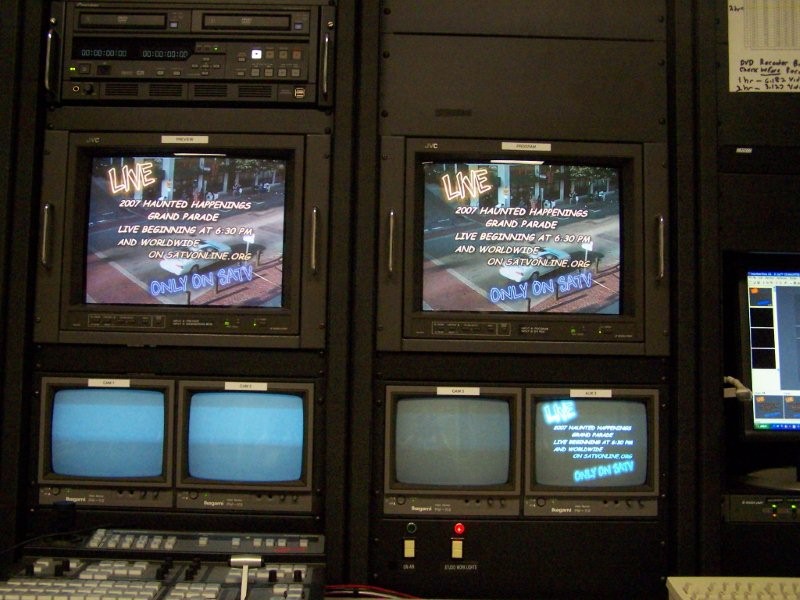
[SATV studios, before the Haunted Happenings Parade]
SATV gets a mention in a Boston Globe article in the North local section of Sunday's paper:
Salem Access Television is currently offering some limited on-demand programming on its website, said its executive director, Sal Russo.
The organization plans to expand that feature next year, when it has completed computerizing its cablecast playback operation, and to eventually offer Web streaming, he said.
"The initial reason to do it is to make your programming more available to your community members who cannot watch it when it's on the channels," because of their schedules, Russo said. "But the ultimate benefit is that anyone can see it once it's available on the Web, which is a good thing."
I've written about our cablecast operation before. We've done experiments with live streaming, the most recent being the Haunted Happenings parade, but we've never been able to offer this full-time.
There is a lot of material we could air over the web if we had the means to do so. Right now, we're using Ustream.tv for live programming, after looking all over for a streaming provider we could afford. I want to put the Salem Commission on Disabliities meetings online and am trying to move things forward with the city on that goal.
We have Windows Media Services on our SBS box. It works great. We just don't have the bandwidth to self-host our operations. (Per usual best practices, our web site is hosted at a third party.)
For us, and most other access facilities, we can only move in baby steps as our funding permits. I'm not comfortable relying on a Web 2.0 provider like Ustream, but that's the best we can do. The facility in Newburyport uses blip.tv so we're not alone.
Our engineer is supposed to arrive to start construction on the new cablecast in January. I have promised to be the first to take a sledgehammer to the old, and fervently hated, wooden cabinets.
Original article: Webcasts bring local access cable TV shows to the world - The Boston Globe
[Crossposted to David Moisan's Blog]
Halloween 2007: The Crush Begins
You may have experienced the crush of people at yesterday's Red Sox rally (I didn't go.) We experience it once a year. 100,000 people are expected tonight, with a heavy police presence to go along with them. That's the NEMLEC mobile command post in the photo.
I have a police scanner and I've been streaming it over the web for a few years. Unfortunately, my server I use to stream is broken, so after going to plans B, C and D, I set up a Shoutcast streamer on my desktop machine. It's at http://n1kgh.gotdns.org:8000/ and is openable in Windows Media and Winamp.
I was supposed to make an obligatory "Is celebrating Halloween in the true 'character' of the city?" but the Boston Globe already beat me to it; After we get through tonight, I'll say something.
Friday, October 26, 2007
Halloween in Salem: It begins
Tonight is the beginning of the busiest five days of the year for Salem: Halloween weekend. Halloween falls on a Wednesday this year. Almost everyone who comes for the holiday, does so as a day trip, so many different people will come.
The crowds tonight were moderate, more like the crowds on Halloween night were 10 years ago. I don't attempt to navigate the crowds on that night, but I'm going to the fireworks at Salem Depot, since I live nearby.
I have an opinion on Halloween in Salem and its effect on the "character" of the city that I'll express in another post.
Thursday, October 11, 2007
Political Activism and Putting Disabled People on a Pedestal
I have been involved in some way or another with disability activism for over 12 years. One of my first web pages was a disability page (The Invisible Disability Page) which spawned an email list that's still active, though I don't run it anymore.
I've watched the Salem Commission on Disabilities struggle to get things accomplished in the city. We have no budget and are an advisory commission; as I said in a previous post, we rely on moral suasion to do our job.
It's easy to be a "disability spokesperson". All you have to do is just appear (and stand or sit) while everyone tells you just how courageous and heroic you are. "Oh, what a role model you are for today's youth!" I've seen a number of disability advocacy groups (and worse yet, have been in a few of them) that get the funds in this way.
I note with no small amount of cynicism that that is what not a few politicians and community leaders want out of the Commission. Just put the cripple of the month on the podium and say nice words about "courage".
Through the invisible-disability list, I was alerted to a great article by Ruth Shagoury Hubbard in rethinkingschools.org The Truth about Helen Keller, with this money quote from Helen herself:
"So long as I confine my activities to social service and the blind, they compliment me extravagantly, calling me 'archpriestess of the sightless,' 'wonder woman,' and 'a modern miracle," Helen wrote to her friend Robert LaFollette, an early pacifist who ran for president as a third-party Progressive candidate in 1924. "But when it comes to a discussion of poverty, and I maintain that it is the result of wrong economics - that the industrial system under which we live is at the root of much of the physical deafness and blindness in the world - that is a different matter!"
Seemed like Helen was a quintessential firebrand socialist! We can't be that feisty--our commission by necessity is non-partisan, even in this blue town, but her attitude is something I want to live by.
I can't count how many times I hear from disabled "spokespeople" who seem to all say the same things: "I want to be an 'ambassador of good will"' "This disabling condition is so Hard but it teaches me Something Important about Myself/Society/The Universe" "We need more funding/sensitivity/good feelings for <the disease of the week>!"
Those sentiments are what token disabled people say, and I hate tokenism and the twee sentimentality that is too often part of the disability experience!
Our meetings are very unsentimental. Oftentimes, they have topics brought forth from problems our residents have. Things like sidewalks being too rutted for wheelchairs, or trees planted in the way of someone trying to use a walker. Or the endless handicapped parking space circus.
It is just as you would expect from a good committee. Lots of discussion. Some yelling. If we're good, some issues get to be resolved right there. More often the case, things are put off to a hopeful resolution in the next meeting. Remember, we rely on moral suasion, so a good outcome just means we got the city, the state or a property owner to go along with our suggestions.
And the meetings are broadcast on local cable TV, so the whole city sees what we do.
You don't get the work of the city done by being a token for anything.
My chairman has multiple disabilities and he is raising two special-needs kids himself. I don't always agree with the things he decides on, but he's put in the effort to be informed on disability issues. He's no token. Or my fellow commissioner Andy LaPointe, blind but an absolute demon workaholic! He's no token either. None of us are.
No wonder that I'd rather follow my colleagues on the commission, than any twenty "courageous, inspirational crips" with no other talents other than to be pitied on the podium.
I didn't apply for a commission seat just so I could be a token. I'm using my talents in IT and video to balance the needs of people with disabilities, against the tyranny that the majority tends towards. And I am a fervent believer in transparency.
You don't do those things by being a token.
Wednesday, October 3, 2007
The 2007 Haunted Happenings Grand Parade
Marchers watch the rising moon as they wait for the 2006 parade to get under way. Photo by the author.
Tomorrow night (October 4th), I'm going to be in a parade. If you've never been in a parade, it's an amazing thing. I first marched in a parade only a few years ago, in the defunct (and bitterly missed) Salem Heritage Days Parade.
Last year, I marched in the Haunted Happenings Grand Parade with my good friend Leo Jodoin, producer of Salem Now and chairman of the Salem Senior Recognition Committee. This year, we were invited back and we accepted! We will be riding courtesy of Salem Trolley.
Salem Access TV will have coverage and a live Internet stream through Ustream. I'll post the URL a little later tonight.
Haunted Happenings Grand Parade set for Thursday - Salem, MA - Salem Gazette
Sunday, September 30, 2007
"Salem's Last Road" September 2007 Update
So far as I know, the Salem Bypass Road is on time for opening next summer. This is a view of Bridge St. @ St. Peter, the southern end of the road.
Note the pedestrian. This intersection is currently the widest in Salem, though this will change soon. The solid red line indicates where Bridge St. will be relocated; it will be jogged 100 feet to the NW to meet the new road. Even with that, the spot that that woman is crossing will be five lanes wide.
I have definite mixed feelings about this as a pedestrian. Instead of the very congested, but managable Bridge St. to cross, there is now a wide river of road between my building and the train station.
Thursday, September 20, 2007
Salem Depot and the Steps of Doom
In yesterday's Salem News (Wed., September 19th), Ed Carberg, of Gloucester, wrote about Salem Depot, the train station I have complained about in numerous past posts.
He puts it well:
Salem’s railroad station is positioned differently from those in the cities and towns that precede it. While the stations that come before it are either higher than street level or at the same level, Salem’s is below it, facing a high wall going up to the intersection of Bridge and Washington streets.
I do not consider Salem’s station attractive or overly welcoming. Worse than that is the manner of normal exit from it.
How would you like to be a traveler with a fear of heights, or any type of vulnerability? Well, I am one of these, and the Salem station certainly brings such fears to the surface with its stairway to Bridge Street in a state of semi-repair. "He is not the only one who finds these steps scary. To a person with low vision,
stairs--particularly loose, broken, dark or just not well marked--are their
mortal enemy!
I had the dubious distinction of falling down these steps a year ago. I only sprained my ankle, but it hurt for some time and every time my ankle throbbed, I cursed those steps! It still hurts!
That's not been the only problem with those stairs. Several years ago, the top platform at street level had to be reconstructed when the concrete panels rotted away, leaving a 20 foot drop to the ground below.
Salem Depot is not quite 20 years old in its present location!
Mr. Carberg uses the wheelchair ramp that's about 50 feet from the stairs (off to the right in the photo.) Perhaps I'll have to do the same.
Tuesday, September 18, 2007
The Salem Commission on Disabilities
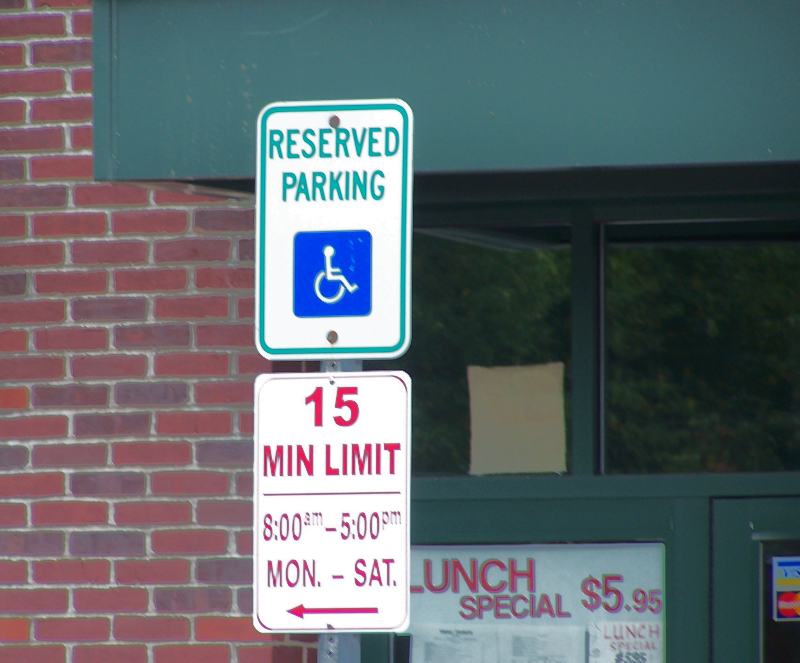
Handicapped parking sign at Museum Place, Salem
This past summer, I was appointed to Salem's Commission on Disabilities. What is the Commission on Disabilities and why am I there? Why should Salem care?
According to the Massachusetts Office on Disability, city and town disability commissions have the following objectives:
Commissions on Disability are established by vote of Town Meeting (in towns) or City Council (in cities) to promote the inclusion and integration of persons with disabilities in the activities, services and employment opportunities in the community.
Massachusetts passed enabling legislation for commissions on disability in 1980. Salem established its own commission in the early '80s; the late Andrew Quinn was the first chairperson. Jack Harris and Charlie Reardon are our current co-chairs.
Why am I involved?
I've written about disability issues before on the blog, and even earlier, with one of the first web pages on invisible disabilities.
I'm too familiar with disability issues; my foster mom hurt her back in a car accident some 30 years ago (the driver wouldn't wait for her to get in the car and she dragged my mom about 10 ft. down the street) and was since confined to a wheelchair.
Some years later, she made the cover of our weekly paper: She would go to the local CVS in downtown (then, and still, on Essex St.) to get her prescriptions, but she couldn't open the door to get in with her chair. I'll never forget--or forgive--the person in the letters column of the newspaper telling her, in so many words, to "stop complaining and just ask for help!"
That got my back up and still does. This attitude still persists, as in this article in the Globe Magazine this week, "Access Denied". Geoff Edgers took to a wheelchair for the day to see if access was improved for people with disabilities since he did this experiment in 1995.
He goes to the Charles Playhouse to get tickets for Blue Man Group. No ramp. 26 steps to the stage. He couldn't even get to the box office due to a truck in the way. The clerk at the box office offered to "get him carried up [the steps]. Lots of people do that."
Um, no.
Carrying someone in a chair is one of the most dangerous things you can do, for yourself and for the person you're helping. If the person is in a motorized chair, as many are, it's virtually impossible. I have had to help my mom move her chair a few times and hoped never to have to do it again.
Sidewalks are no better. Edgers discusses sidewalks and the infamous sloping walk on Boston's Huntington Ave., but I can think of plenty of examples just in Salem. Salem has cobblestones (!) in the Essex St. pedestrian mall, and they are miserable for just about everyone except the historical purists who installed them in the first place. Never mind people in chairs.
We have our share of "historic" brick sidewalks, many of which start crumbling as soon as they're put in, by their very design!
Homeowners with disabilities have problems, too. A disabled woman in Vinnin Square may have to move from her unit due to a dispute with the neighbors over the chairlift she installed on the common stairway she and her neighbor use to get to and from the sidewalk. (From the photo in the Salem News, I count at least 20 steps; even a single step can be unnavigable for one in a chair!)
Later in Edger's article, he quotes Bruce Bruneau, formerly of the Massachusetts Office of Disability. Bruce is discouraged:
"I thought I could make a change when I started doing this," Bruneau says. "I was wrong."
I've always held a cynicism towards most government, but I share Mr. Bruneau's discouragement in particular. Not everyone believes in access for people with disabilities.
People complain about the cost. They complain, to quote one of my former colleagues, about "those activists". I was talking about the Vinnin Square situation with a friend and was telling me how my commission didn't know about it until it hit the paper. He told me point blank that my commission doesn't get informed about situations like Vinnin Square because all we do is "want want want!" (My friend has never been to a meeting and doesn't know a lot about the Commission, but I was very hurt. A bitter irony is that he has a disability and his town has a commission like ours, and, the chair is a colleague of mine!)
I've heard all the other complaints through the years: "You want special rights!", "Why don't you have shops/coffeehouses/drugstores just for people in wheelchairs!" (otherwise known as "separate but equal", if you remember your history) "Can't you just stay home?" "Can't you just get help?" "Can't you work harder and overcome your disability?" "Just get rid of that illness thing!"
People with disabilities are a minority and thus especially vulnerable to "the tyranny of the majority", as Edgers' article makes very clear.
The Salem Commission on Disabilities is a civil rights commission, the only such commission in our government. We are an advisory commission and can only get things done by moral persuasion. Sometimes, we get a victory, as when we were involved with the Bates School renovation and got the contractors to realize all the bathroom fixtures in the kids' restrooms were adult-sized!
Other times, we have dealt with handicapped parking issues in the same locations (such as Salem Depot) again and again without any resolution. The Commission has complained about the cobblestones in the Essex Street Mall for well over 20 years to no effect. Prior to my confirmation on the commission, I saw and videotaped their meetings for 7 years and I cannot count the number of issues discussed that are still unresolved years later!
In the history of human rights, there has never been a population needing their rights that has ever had them handed to them ("Yup, we oppressed you and we're sorry, here are your rights!") They've always had to be taken. And no one involved has ever been comfortable.
Most people have an idealized conception of disability. People such as the late Christopher Reeves are "heroes". If Reeves were still alive and he wanted to come to Salem again (as he came to Salem State a few years before his death), he wouldn't need "civil rights". He was so beloved that people would line up to lift his chair for him and open doors.
But civil rights aren't just for the great and the good. If that logic were true, we wouldn't need the First Amendment for "good speech". But we know we need it for "bad speech" or at least speech that some would not want to hear.
Civil rights are for all. They're never easy to assert or to enforce, ever. But they're for all of us.
They are for your friend with a cane. They are for that woman in Vinnin Square.
These "special rights" may even be for you yourself! Remember that people with disabilities are a minority that anyone can join without warning, through accident, illness or plain bad luck.
(Sadly, some elected officials learn this first hand: A few years ago, the fine for illegal parking in a handicapped space was increased. One of the sponsors of the ordinance was then-Ward 1 councilor Scott LaCava, whose wife had to have both legs amputated after she was run down by a reckless driver.)
My foster mom did not live to see this, but CVS eventually put in automatic doors in all their stores. I may be pessimistic and cynical, but I am also stubborn. I'm taking my post on the commission for her memory, and for that of all the citizens, employers and visitors of Salem who will use and need our services.
For everyone.
Tuesday, September 11, 2007
Train runs on fumes!
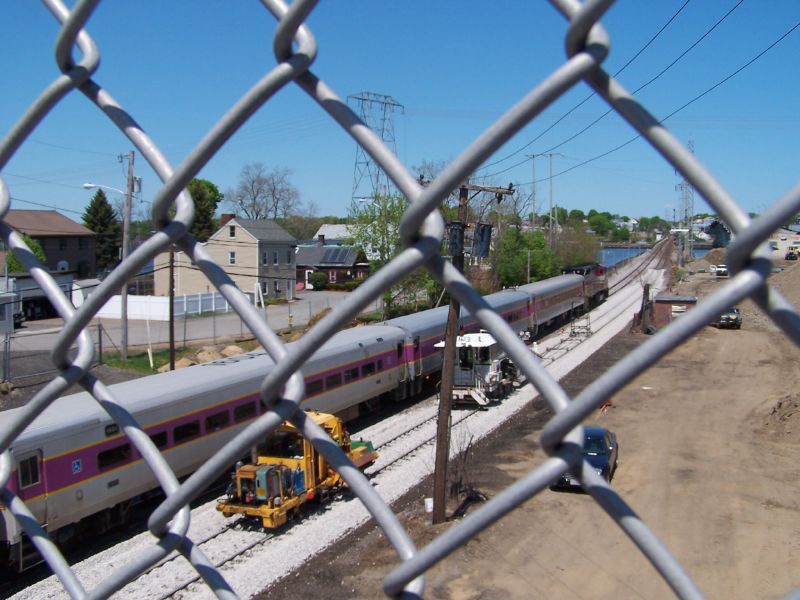
[Beverly train passes a work crew under March St., Salem]
According to a poster on livejournal, and on railroad.net amongst other places, the 7:30 train from Rockport this past Sunday ran out of gas! True MBTA story!
Would have been funny if the train ran out of fuel under Salem, and if I'd been on it!
Wednesday, August 29, 2007
Salem, The Once and Future Walking City
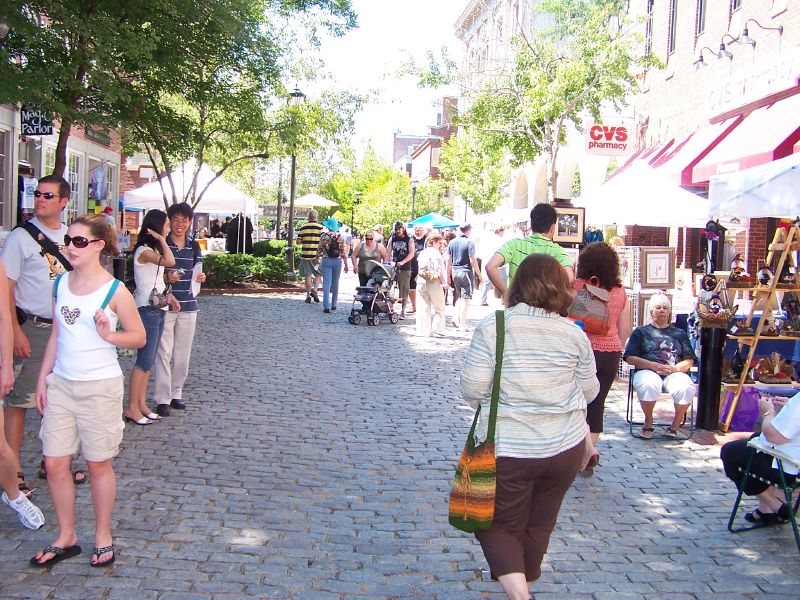
[Essex St. Fair, part of Salem Heritage Days]
Continuing my last post on a car-free or at least car-neutral Salem, there's an interesting site called WalkScore.com. Plug in an address and it will mine Google Maps and give you a score that corresponds to the "walkability" of that location; in other words, the number of stores, restaurants, parks, libraries, schools, municipal offices and other amenities in walking distance.
The Walk Score for my home is 92. That's very good. The scoring system is limited by the information in Google Maps and the accuracy of its address database and by the distance measurement, which is as-the-crow-flies rather than walking distance, but the site is reasonably accurate for Salem, which doesn't have very many cul-de-sacs.
Walkscore, of course, cannot evaluate any of its listings on the variety of shops or the income level of any of their shoppers; I've complained before about the shops in downtown mostly catering to either the affluent or the tourist, neither category of which I fit in.
Still, as bustling as downtown is becoming, I remember when it was much better. If Walkscore had been in existence in 1970, it would have scored my downtown well over 100. There were many, many, many stores and establishments in downtown Salem. At one point it was the retail capital of the North Shore.
This is a part of Salem's history that is often willfully ignored. It doesn't have the property-values snob appeal of Nathaniel Hawthorne's era, but Salem's retail history is a proud one that I was fortunate to grow up in.
And I miss it terribly.
People have told me, "oh, you can't have those days back again!" Why not? The downtown of that era had everything! It was a time when Salem was a great working-class town for all, not merely the 18th-century-historic-themepark crowd that inhabit the city today.
I'll bet if Nathaniel Hawthorne had shopped at the old Almy's, that the store would have been preserved intact with its original use, instead of being torn down for condos in 1984.
Take care.
P.S. Kirk Westphal produced a great video as part of his master's thesis, Insights into a Lively Downtown. This 19-minute documentary about Ann Arbor's downtown is very applicable to Salem.
Friday, August 24, 2007
The Car Culture's Limit in Salem
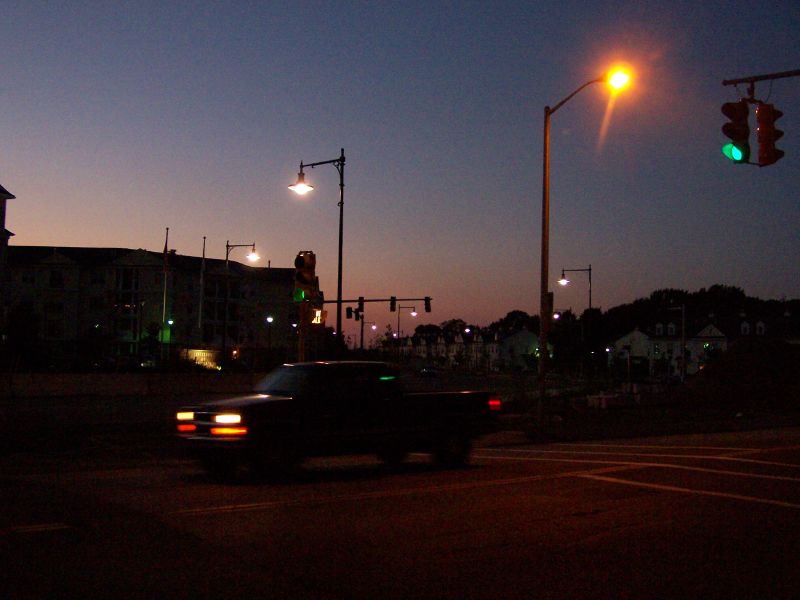
[Bridge & St. Peter St at sunset, looking towards the bypass road.]
For once, there's an op-ed in a Salem paper I'm not screaming at (*cough* Taylor Armerding *cough*). Robert Moran's column in the Gazette, Salem as a change leader, says out loud what I've been trying to say in this blog: Salem has never been able to adapt to the Car Culture of the post-1950's and it should not have even tried.
Salem is often compared to other cities in the region like Peabody and Beverly that have direct access to major highways like 128 and 95. Why can't Salem have these, people ask? The Northshore Mall has a parking lot that is as big as the core of downtown Salem; why can't Salem have one that size?
Why can't Salem have more cars on the streets? Why can't Salem have more parking? Every so often, a business leaves Salem, such as the old Sears Credit in Shetland Industrial Park, and the refrain is, "Oh, if we had more cars/roads/parking, they wouldn't have left!"
Salem is a small city, just over 8 square miles of land. Virtually all of the developable land (apart from wetlands and parklands such as Forest River and the Salem Woods) has already been developed. Most development in Salem is of existing properties, such as Derby Lofts, and the soon-to-be-redeveloped Salem News building.
I've written before about the Bridge Street Bypass Road. That road took 30 years to get built and became a much shorter road than was originally proposed. The rancor surrounding this project has been so great that it's unlikely we'll ever see another project like that in our lifetimes.
Nor should we.
But it will take more than my desires to change things. To quote Moran:
While dreamers imagine utopia, many shiver as chill sweeps the spine: “How would I get anywhere? I’d have to buy a horse. The city would stink of horse poop. Either that, or I’d spend life tethered to a bureaucrat’s schedule, hanging around bus stops, and hoarding change.”
I'm delighted at the thought that the property-values activists on Federal St. may have to own horses and park them on the sidewalk instead of their SUV's, but kidding aside, there's a truth there.
Public transportation in Salem, as in most of the state, is a non-starter for most households in the city right now. There is no way one can ask the head of a family to wait in the snow or the rain outside Market Basket for the #450 bus that only runs every hour and that is usually late.
Back in the day, there were groceries like Salem Market (now Red Lion Smoke Shop) and Finast (now a Walgreens) downtown. The Boston St. area had Giant Valu, then Crosby's, then nothing. Repeat this for clothing stores, sporting goods and so forth. How many bakeries were there downtown back in the day? Versus now? (only A&J King on Derby St. and they survive on the Derby Loft yuppie traffic.)
You can't live on the shops downtown.
Even the number of convenience stores in our neighborhoods has declined; it's easier to drive a quarter-mile to Hess or 7-11.
Highland Ave. has all the retail, but it is a miserable place for pedestrians and T riders to navigate. (Try coming back from Walmart and crossing the street to get your bus back. With kids. Good luck.)
Ultimately, I'm pessimistic over the prospects of alternative transportation. It'll take a crisis like the Second Energy Crisis to motivate people and even then they have to be convinced things won't change by the closing credits.
But it's good to have at least a few people in the street aware of these things.
Wednesday, August 8, 2007
Rainbow at the ballgame
A rainbow at Frasier Field, Lynn, bottom of the first. Sadly, it was the highlight of that evening since the game was called shortly thereafter.
Storm clouds at the game
It was supposed to be a night at the ballpark with my college's alumni association (Salem State College, 1987). Unfortunately, I know these clouds too well--I'm a trained severe-weather spotter. No tornados here, but a *very* nasty downpour that ended up in the game being called. Sigh.
Tuesday, July 31, 2007
Courthouse Traffic Impasse
[Originally published in the Salem Gazette]
To the Editor:
I’ve been following the controversy over the traffic plans for the courthouse project and am feeling more and more frustrated. Community activists on Federal St., as well as the current and past occupants of City Hall, have chosen to forget how this impasse came about in the first place. The courthouse traffic plan is linked with the North St. reconstruction project, the Boston St./west Bridge St. reconstruction, but most importantly, the Salem Bypass Road currently under construction.
The route of the Bypass Road from the bridge through to St. Peter St., wasn’t the first routing proposed, nor was it even the best. Better routes for that roadway would have been through to Harmony Grove Ave., Flint St., or even Washington St. as the Salem Partnership once proposed. The Salem Partnership proposal even featured a new Salem Depot with street level bus bays.
That was not to be. The current routing was a default choice, because none wanted the roadway anywhere near their “historic” neighborhoods. With the exception of Leonard O’Leary and Mike Sosnowski, everyone in City Hall from current and past generations, from the Mayor’s office to the council chambers, has chosen to pretend that the bypass road will magically solve Salem traffic.
And why not? It isn’t anywhere near Washington Square, Chestnut St. or Federal St!
One woman at the most recent traffic hearing was complaining about a computer model of the proposed approach to North St. “It looks like New Jersey!” I live at the foot of the Bypass Road. I’ve seen the road and looked at the blueprints in Sue Cranney’s office (Ms. Cranney is project manager for the road.) I’ve walked on the road! If you put “Salem Bypass Road” in your internet search engine, you will likely find my pictures.
THAT is New Jersey!
I use public transit almost every day, since my disabilities leave me unable to drive. Instead of walking a short distance to a new train station, I walk through a five-lane highway, down decrepit stairs to a decrepit train station to get a bus. Why don’t we have a new train station? It would destroy the “character” of Salem. The Salem I know has had a rich past history of train travel, and currently has the busiest station on the Rockport/Newburyport Line. Apparently, this isn’t important to the activists in the historic districts.
Consider that residents at the Jefferson complex on Howard St. are surrounded on three sides by the Bypass Road; in this supposed “transit-centered” development, the Moon is closer than the train station if you’re on foot! There wasn’t much outrage when that “luxury” housing was approved!
And we still pretend the road will do any good. We pretend that we can change traffic in “good” neighborhoods and it won’t affect traffic anywhere else.
The MBTA is now planning a new depot and garage for Beverly. They may feel Salem isn’t worth having a new train station. Perhaps they know more about the traffic situation than we’re willing to admit. As for the courthouse, John Keenan shouldn’t worry: He’ll still get the law library named after Sam Zoll.
It’ll just be in Beverly.
Wednesday, June 13, 2007
Monday, May 28, 2007
The Second Energy Crisis and People with Disabilities
[This post is part of World Without Oil, the alternate-reality game. This is fiction, but my opinions are based on fact.]
According to the Salem Commission on Disabilites, 20% of Salem residents have a disability, a condition that impairs their daily life. About 1 in 10 of them have a serious disabilty that requires frequent and regular care. These include paraplegics and quadriplegics stricken by illness or accident and people with muscular dystrophy, MS or ALS to name the most obvious cases.
There are less obvious cases. The co-chair of the Commission (and a dear friend) has two adopted developmentally disabled daughters. (They're charming kids!) They need regular care.
Diabetic people are often not thought of as having a disability until something goes wrong. People with diabetes don't only have to worry about their meds, but they have to eat well, too. If not, the aftermath is not pleasant.
Can you even get your meds? (also see Meds and the USPS) What about chemo patients? Many elderly people need regular care, whether they're in nursing homes, retirement communities or just left by themselves in public housing (as I've seen too often in my building.)
If people lose their nurses and their care attendants, they'll head right for the emergency room. That is scary.
I'm fortunate in a few ways: I've had five eye surgeries (retinal detachments) and have kept my sight. I've always had low vision and cannot drive, but all I need is to be able to read books, use the computer and tinker with ham radio stuff. Even still, there have been bad times recovering from one operation or another, or suffering one complication or another, where I've been virtually blind for weeks and months.
What if you were in an accident and suffered a detachment? And a surgeon wasn't available (retinal surgery is very specialized in both its practitioners and its equipment)? You'll go blind. Untreated retinal detachments are not fixable. That's just one of the many dilemmas we face.
Another question: Our disabled Salemmites--are they working?
According to the Center for an Accessible Society, 30 percent of people with disabilities are unemployed. (The figures for blind people are even worse: 70 percent unemployment.)
The Salem Commission on Disabilities is considered a civil rights board, but many businesses consider it just another layer of bureaucracy. People with disabilities are a minority, and a common libertarian argument that many people subscribe to is that it is not worth the added cost to the majority (the business owner) to accommodate people with disabilities either as customers or employees.
(Anyone remember that old public service ad from the seventies? The one where a couple couldn't get education for their learning disabled child because the administrator told them, "we can't do this for only one child"! Many still think like that!)
When times are tight, businesses will not see people with disabilities as an asset, but a liability. We are already seeing this with health insurance; if an employee "gets" a disability or any sort of health crisis, premiums go up, and suddenly, the employer can't afford to keep that person.
Many people with disablities rely on gas-powered vans to take them to work and to shop. They just became homebound in the Second Energy Crisis.
People with disabliities have gained and kept their independence because we have been rich enough to lend a hand. At the first sign of a crisis, people with disabilities will be the first to lose their independence, if not their health and life itself.
It's very scary for us out there.
Take care.
UPDATE: Casuabon's Book goes into some detail on how Peak Oilers look at the poor and people with disabilities.
Saturday, May 26, 2007
Salem's Future in a Second Energy Crisis: Recommendations
[This post is part of the World Without Oil game. Events in the game may not be factual, but my opinions are real.]
In the fall of 2006, RCG, a large developer based in Somerville, had plans for the downtown. They planned to develop 180 condos on three six-story buildings with a 500 car underground garage.
In public hearings, the plans were excoriated, with public response almost unanimously negative.
Last December, RCG cancelled the project.
[UPDATE: RCG came back and agreed to develop a smaller project to begin in April '08. Whether it was a negotiating ploy or an acknowledgement of changed circumstances is unknown.]
That was probably the best thing to happen to Salem.
In the mid-90's to the present, Salem and many other North Shore communities had condo fever (or luxury-apartment fever). Developers promised us the moon and the stars if we would let their projects be built. The people they hoped to have live here, at $400,000 per mortgage, were said to be dynamic, up and coming and added to the "character" of the city. Money really was the "report card of life" as they say.
In Salem, history was not a fact but an attribute to be sold. Too often, history represented nothing more than property values to the developers and to those that moved in.
Worse yet, Salem was becoming a bedroom community, slowly losing the diverse economy it once had. Those that moved in, and those living in "historic" districts came to believe Salem was a fantastic historical theme park, a perpetual Currier & Ives print where the horses never poop, where you can live in 18th century houses and still park your SUV's on the sidewalk on Federal St.
In a city, you are never far away from the infrastructure that you need in order to live. Roads, sewers, water mains, power plants, substations, rail lines, gas stations, garages, streets and sidewalks are all necessities today, just as stables, carts, wagons, rail lines, trolleys, markets, docks and sheds were in historic Salem. People sold on the historic fantasy become very resentful of this fact, as we have seen when the Federal Street association killed the Salem Depot project.
Salem was not and is not a bedroom community or a historic theme park. It was and still is the crossroads of the North Shore. If you understand that, Salem is a great city. It was and is a living city.
As we go through the Second Energy Crisis, I have recommendations to insure that Salem remains vital:
1) We must diversify our development. We cannot depend on an endless stream of affluent yuppies to inhabit luxury condos. Because there are no amenities downtown for them, they will have to drive--remember that proposed 500-car garage? This was already questionable even before the gas crunch, let alone now.
We let our commercial tax base disappear, as former factories like Parker Brothers became luxury apartments. This must not continue. We need more commercial properties such as offices, light industrial and the like. It's a crime that the old Sylvania property on Boston Street has never been developed.
Even more importantly, we need more retail downtown oriented to residents. Losing our old downtown as we did is still a blow all these years later.
2) Salem must have improved public transit. Public transit is not "welfare transit" but a vital link for people within the city and outside it. The Blue Line must be extended to Lynn at a minimum. The decaying Salem Depot must be renovated and serious consideration given to electrifying the Rockport/Newburyport Line.
Blue Line service to Salem should be seriously studied. If it's not possible for technical reasons, the MBTA should also consider converting Route 455--the busiest T route in Salem, serving the Point, Salem State College and South Salem--into a trolleybus. Or at least making it a frequent (15 minute) feeder serving the new Blue Line at Central Square, Lynn.
3) We must consider life without the powerplant. This is a recommendation for which I don't have a good answer. Dominion's Salem Harbor Station is a polluter, but it is also our largest source of tax revenue. It's also our backstop against power blackouts on the North Shore.
Nevertheless, we face Global Warming as one of our many challenges. Some scientists, such as Dr. Hansen (well known from NASA) have recommended phasing out coal-fired power plants, such as Salem's. Our plant is old and it's not certain whether it could have the necessary technology (carbon sequestration) fitted to continue operation.
Salem will have to imagine scenarios without the power plant and deal with them accordingly.
4) Put a moratorium on new parking garages and major road projects. Salem's Last Road really is Salem's last road. Since writing this, I've learned that the private garage planned for 10 Federal St. (next door to me as it turns out) is now on hold. It might turn out that we should build a garage at the Salem Depot as was originally planned, but I believe it'll be the last one for the foreseeable future.
Lastly, I want to remind elected officials, neighborhood associations and citizens of one point again: Salem is a Living City. Our purpose is to make Salem a prosperous city for everyone who lives, works and visits in it. Salem doesn't exist to boost your property values or give you a historic fantasy, and it isn't an empty vessel for developers.
With good leadership and citizens who recognize the kind of community they live in, Salem can get through the Second Energy Crisis much better than many other suburban communities.
Let's get started.
UPDATE: Perhaps Portland, Oregon could be a model for us?
Saturday, May 19, 2007
Salem's Future in a Second Energy Crisis (Part 2)
It's 2007 in Salem, 33 years after the First Energy Crisis. What's different?
There are many, many more cars in Salem than ever before. In 1974 there were few parking lots, one of the biggest being the Almy's lot at Church St., in the rear of the store. There were also lots at Rich's and Giant Valu (a grocery store), the biggest stores on Highland Ave. at the time.
There were no malls and no parking garages.
In 1976, Salem's first parking garage was built on the site of the old Paramount Theatre on Essex St. (adjacent to Almy's). Salem's first (and second) malls followed, the East India Square mall under the garage, and the Hawthorne Square Shopping Center on Highland Ave (between Rich's and the then-new Salem High School.) The first private parking garage would not be built for another 10 years or so, when Naumkeag Mills, the big factory complex at Palmer's Cove was redeveloped as an industrial park.)
Today, Salem has 3 garages (2 public, including the new South Harbor Garage, and 1 private) and officials want to build at least 3 more (including 1 private garage.)
With an increase in cars has come a decrease in commercial space. Virtually all of the factories in business in 1974 are now gone. Parker Brothers is gone, and now "luxury" apartments are on the site. Sylvania closed both its Salem plants in the early '90s; one of them belongs to Salem State College and the other is an empty lot, undeveloped due to litigation from the neighbors. Except for the remains of Flynntan, you would almost never know there was an industry.
Salem's downtown, as a shopping area for residents, is dead. Almy's is long gone and the East India Square mall was remodeled into Museum Place and, like downtown itself, primarily caters to tourism. The old Jerry's Army and Navy--the big clothes store downtown--closed long ago and you can no longer buy baked goods at Bowman's or chocolate at Connelly's; they're gone too. (I bitterly regret the loss of Connelly's, since if they'd only held out for a little while longer, they'd catch the gourmet chocolate wave and I would be there every day!)
What industries Salem has are tourism and condos. Recent administrations and city councils have grasped onto luxury condos as the answer to Salem's decline. In 1974, very few people lived downtown outside of rooming houses. In 2007, there are some 500 (by my imprecise estimate) housing units downtown (in a square bounded by Bridge St, Hawthorne Blvd., North St. and Washington St.)
(Disclosure: I'm one of the 500 units, living near the train station.)
Most of these new residents are carrying mortgages up to $500K. In downtown Salem (!!) Virtually none of these people can shop without a car. There's nothing for them. So they have to get in their cars and drive at least to Highland Ave., or more often to Danvers or Peabody. And shopping drives our economy in the US.
Salem is not like, say, the Back Bay of Boston with Newbury St and Boylston St. where there are many choices and many opportunities to shop on foot (or at least with a handcart to take that LCD TV home!)
We've always had lots of traffic--we are the crossroads of the North Shore--but these developments have given us even more. So much more, that the previous administration pushed through a new roadway, the Bypass Road, that I wrote about in Salem's Last Road.
In 2007, there are 4 bus lines and the commuter rail, terminating at a truly depressing train station. I'm the only one I know who uses public transit--I can't drive due to poor vision--and it is not fun humping groceries home on the bus. In 1974 you could ride a bus to Marblehead. Not any more.
A few politicians have talked about improved transit. Every so often, the idea of extending the MBTA Blue Lynn to Lynn and Salem comes up. It's been often shot down in Salem; it would "destroy the character of the city". (The Blue Lynn to Lynn project exists only because officials in Lynn have pushed it very aggressively.) Much-needed improvements to Salem Depot were killed by one of the neighborhood associations several years ago (These associations are de facto arms of government composed of wealthy property owners more intent on preserving property values than the quality of life for themselves or anyone else in the city.)
Public transit in Salem is usually seen as a welfare program to get the domestics and other "low-class" service employees to work. (My family was lower-lower middle class and I am no prize in the social strata category myself, so don't take offense.)
As mentioned in the last post, Salem Harbor Station still operates now, as in 1974. It still runs on coal and still pollutes. Unfortunately, it's also the biggest commercial taxpayer we have. We're stuck with them and our increasing need for power. It'd seem that coal would be immune to the oil shock, but the coal barges, do they not run on oil? We also have an oil terminal and a LNG facility on the waterfront. The old Boston Gas (now Keyspan) aggressively pushed natural gas heating, as did other utilities.
We are no less vulnerable to the Second Energy Crisis than any other North Shore community. In fact, we're worse off.
Our car-centered, congested, historic little city is headed for disaster. The average Salemite would be screwed without their car. They need it. They can't walk to the neighborhood store; in many areas of Salem, they no longer exist! Where will they work? There are few jobs in Salem that aren't low-wage service or tourism jobs.
So what's next? We do have some strengths, and they don't depend on escalating property values for a few. We can still respect our history yet make a viable future for our city.
[To be continued.]
Salem's Future in a Second Energy Crisis (Part 1)
I remember being around for the first Energy Crisis (which I place in 1974 for discussion's sake.)
Salem was still a tired little mill city, like Lynn or Peabody only smaller and more congested. It had a downtown with lots of stores, including Almy's, a local department store chain.
It had factories. Mills and tanneries and machine shops. Sylvania, the big lighting company, had two factories in town, one in South Salem, and the other in Blubber Hollow (famous for the Great Salem Fire, near where I lived at the time.) The great Parker Brothers factory still existed. There were places to earn a good middle-class living. The great decline of the middle class hadn't yet happened. Nor had the decline of downtown, at least not yet.
Cars were becoming necessary in Salem and the North Shore, but one could still shop for everything one needed on foot. We had a commuter rail line and 8 bus routes. My family never owned a car; it was hard even then to manage, but we did.
Most importantly, Salem had a thriving commercial tax base with a lot of local employers. This meant a lot for charity and community events, such as Heritage Days and the parade that was held each year.
I can't romanticize this too much; we had serious environmental problems then that still plague us today. The North River turned colors according to what the factories were dumping that day and it still isn't clean today. As typical for the tannery business, many of the factories were firetraps. (I remember too well when the Flynntan factory on Boston St. burned, since my mom woke us all up at 3 AM when it happened; if the house burned, we were going to sleep in Gallows Hill Park as a previous generation did during the Salem Fire. Fortunately, the wind shifted and that didn't happen.)
Of course, long-time North Shore residents will recall the Salem Harbor powerplant and its environmental problems. I'll get to that later on.
What do I remember from the first Energy Crisis? Not much. I remember the glow-in-the-dark Count Chocula sticker that told us to turn off the lightswitch when we weren't using it. Turn off the TV. (In those days, a color TV could run 300 watts, so this was important!) Almy's shut down at 5 PM rather than 7 PM. To an 11-year old, even the newsjunkie 11-year old that I was, this was distant. I didn't have to pay the bills back then.
It's now 2007. What happens to Salem in a Second Energy Crisis? My speculations in the next post.
Tuesday, May 15, 2007
World Without Oil game
Salem's Last Road
 In 2005, after decades of contentious discussion, the state started building a bypass road through Salem. This road begins at the Salem-Beverly (Veteran's Memorial) Bridge at Route 1A and continues alongside the railroad southwest, ending at the intersection of Bridge St. (Rt. 107) and St. Peter St., at the old Salem Jail.
In 2005, after decades of contentious discussion, the state started building a bypass road through Salem. This road begins at the Salem-Beverly (Veteran's Memorial) Bridge at Route 1A and continues alongside the railroad southwest, ending at the intersection of Bridge St. (Rt. 107) and St. Peter St., at the old Salem Jail.The Bypass Road was conceived in the late 70's and was originally routed from Peabody Square through Boston & Bridge St, Salem, through to the Salem-Beverly bridge on a separate roadway. The city of Peabody balked, and the concept was cut back to terminate at Bridge and Flint Sts.
Mass Highway cleared the land between North and Flint Sts, approximately 3/4 of a mile, in preparation.
In the meantime, the MBTA moved Salem's commuter rail station to Bridge and Washington Sts. in 1985 following a fire that destroyed the railroad drawbridge between Salem and Beverly. This complicated the proposed routing, and killed the Flint St. highway terminus for good. (The cleared area between North St. and Flint is now Leslie's Retreat Park, a dog-walker's park.)
In the 90's, the Salem Partnership put forth a proposal and concept drawing (which is strongly burned into my memory since I live downtown, ironically at St. Peter St.) locating the end of the bypass road at Washington St. and building a new garage and street-level busway at the train station.
It seemed like the best idea, but often in Massachusetts, the best ideas go nowhere. For whatever reason this idea--and the MBTA garage at Salem Depot to this day--was DOA.
Former mayor Stan Usovicz--and the downtown business community--lobbied hard for the St. Peter St. terminus. That's how it would be and since late 2005, when construction started, that's what we have.
For $16 million, we are getting just over a 1 mile road, or as one friend calls it, a "second Bridge St." We're getting the road we always wanted; Salem has always been bitter about its congested downtown, seeing the traffic flow, office and shopping areas, go to Peabody, Beverly and Rt. 128 where cars more easily exist. But is it both too much and too little?
Would it be as if the Big Dig terminated at Dock Square?
With an underfunded state transportation budget following the Big Dig debacle, global warming and the scary prospect of Peak Oil, this may well be Salem's Last Road.
Massachusetts Highway Department project page for the Bypass Road
Flickr Set: "Salem's Last Road"
